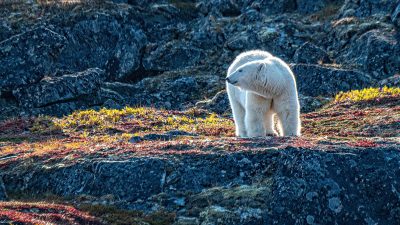Article | Destinations
Prowling with Bears on the Labrador Coast
By Aaron Spitzer | December 20, 2020
Related expedition: Greenland & Wild Labrador: A Torngat Mountains Adventure

©Dennis Minty
Article | Destinations
By Aaron Spitzer | December 20, 2020
Related expedition: Greenland & Wild Labrador: A Torngat Mountains Adventure

©Dennis Minty
Two ursine species inhabit the wild hinterland of Labrador. First let’s talk about ursus maritimus—polar bears. North America’s biggest, baddest predator thrives along the Labrador shore. In the winter they spend most of their time out on the sea ice, chomping seals. In summer they retreat to land, waiting for you to take their photo. (Joking! —But only sort of.)
We most commonly spot polar bears in Labrador’s north, especially in Torngat Mountains National Park. When sailing through the park’s many scenic fjords—whether Nachvak, Saglek, or Ramah Bay—it’s common to see nanuq. Keep vigil on the top deck with your camera and binoculars. Or, simply listen for the call over the ship’s public-address system: “Polar bear ahead!” Then watch your fellow travellers race to the windows.

© Grant Stovel
Of course, the polar bear population isn’t limited to the park. They’re common south of there, too, closer to the communities of the Inuit region of Nunatsiavut, and on down the shore clear to the Strait of Belle Isle. Every so often a polar bear even crosses to the island of Newfoundland or wanders into the Gulf of Saint Lawrence. At this latitude—equivalent to London, England—perhaps they would be better called “subpolar bears.”
Despite concerns related to climate change, the Labrador polar bear population is currently numerous and healthy. Environment Canada estimates that northern Québec and Labrador are home to 2,500 polar bears—one-tenth of the global total, and far more than was predicted at the turn of the millennium. It’s thought the population is benefitting from a boom in its primary food source, harp seals, which since the 1970s have exploded due to a decline in commercial sealing.

© Dennis Minty
So, what about Labrador’s other bear species? They prowl the barrenlands, ambushing ungulates. They splash in icy creeks, feasting on char. They dig dens in the tundra, enduring winters that last from September to June. No, they’re not grizzlies. They’re North America’s strangest ursus americanus—black bears.
Here in Labrador, black bears fill a unique ecological niche. Elsewhere, they are shy forest dwellers, subsisting on small fare—berries, roots, and grubs. But here, unlike anywhere else in North America, they have moved out onto the tundra, and have come to behave like grizzlies. That means they’ve become carnivorous and often aggressive predators, killing adult caribou, gorging on lemmings, fishing, and possibly even catching seals.
Yet despite their taste for blood (!), there’s one way in which Labrador black bears are not like grizzlies: they’re tiny. Males average about the weight of a large man, never more than 280 pounds. Females, meanwhile, are about the size of a big dog.

© Jason van Bruggen
Jason Edmunds, Expedition Leader and bear guard, helps keep visitors safe on the tundra.
What are our chances of seeing these oddly-adapted critters? Well, they’re less common to spot than polar bears, but whenever we go hiking on the tundra, we’ll keep our eyes open—and keep our trained bear guards at the ready!

September 17 to October 1, 2025
From $9,495 to $19,095 USD
per person based on double occupancy
Save 15%

September 27 to October 11, 2026
From $15,995 to $24,195 USD
per person based on double occupancy

August 28 to September 11, 2026
From $11,995 to $22,795 USD
per person based on double occupancy